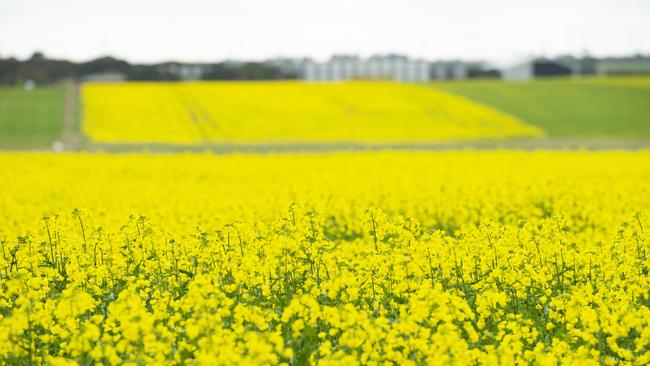‘Great vibe’ for Australian agriculture heading into spring season
Things are looking positive for Aussie farmers for the season ahead — but it won’t be without its challenges, industry warns.

Australian farmers are anticipating a spring flush with success, with all signs pointing toward a season of record-breakers and bumper crops.
With most of the nation having now moved out of drought, solid prices across commodities, and soaring property prices to boot, the season ahead is looking like a winner across the board.
“At the moment when you look at all the general indicators, everything is positive,” National Farmers’ Federation president Fiona Simson said.
“There is a really great vibe out there. Agriculture has again withstood and grown throughout Covid.”
But the season won’t be without its challenges, Ms Simson warned, with labour shortages and uncertainty around state border closures due to Covid-19 outbreaks still threatening to wreak havoc.
The latest outlooks from the Bureau of Meteorology are forecasting above median rainfall for most of eastern and Central Australia until November, with cropping regions in NSW, Queensland and Western Australia already recording more rain than they would expect in a year.
Forbes in NSW has recorded 715mm in the past eight months, equating to 150 per cent of its 12-month average. It’s a similar story at West Wyalong which has recorded 579mm, or 133 per cent of its calendar year average, and Condobolin, which has measured 524mm or 130 per cent of its normal annual total.
In Western Australia, where analysts are expecting a record crop, Morowa and Cunderdin – in the heart of the state’s billion-dollar grains belt – have recorded 123 per cent and 120 per cent of their annual average rain already with four months of the year remaining.
GrainGrowers chair Brett Hosking said growers will keeping a close eye on conditions over the next fortnight to lock in their crops’ potential.
“We know spring is a time when days get longer, crops are busy growing, and it’s also warming up temperature-wise, and we’re wanting to realise the potential in the paddock,” he said.
While ABARES is predicting this year’s grains harvest won’t reach the record high of last season, it’s still forecast to be 13 per cent above the 10-year average, and backed by solid prices.
For cattle farmers, prices are still escalating, with the Eastern States Young Cattle Indicator cracking 1031.5c/kg carcass weight last week — more than 240c/kg above the same period last year.
As the nation’s cattle herd uses the improved seasonal conditions to rebuild, spring bull sales have also reached new heights with some early auctions producing average prices double 12 months ago.
Elders Livestock stud stock auctioneer Ross Milne said “you can count on one hand the number of bulls that have sold for less than $10,000” so far this spring – a figure that would have been unheard of until last year.
In recent days all major NSW bull sales have recorded averages well over $10,000. Wirruna Poll Herefords averaged $16,190, more than double last spring’s $7795 per sire, while Rennylea Angus cleared 168 bulls, averaging $15,690.
Meanwhile, the starter’s gun has been fired on what could be the richest spring for rural property on record, as the pension fund for the world-famous Royal Canadian Mounted Police last week swooped on another multimillion-dollar Australian farm.
PSP Investments, through its joint-venture partners Hewitt Cattle Australia, purchased the historic 3256ha Brewarrana property on the banks of the Murrumbidgee River near Narrandera in the NSW Riverina for about $25 million.
It is the second major farm deal involving PSP and Hewitt Cattle Australia in a matter of months. Last month after the partnership purchased the historic 14,876ha Tubbo Station near Darlington Point for more than $40 million.
Despite the positives, labour shortages across the sector are still looming as one of the biggest challenges, thanks to ongoing international travel bans.
The horticulture sector is warning it’s facing a shortage of up to 24,000 casual pickers over summer, while the grains sector is scrambling to fill contract positions ahead of harvest.
“We’re about 100,000 backpackers less than last year … we know the ability to bring workers in is really challenging at the moment,” Mr Hosking said.
The Federal Government has pledged to have its new agriculture specific work visa – targeting the UK and 10 Asian countries – in place by the end of September; however, that’s no guarantee of when the first the first workers would be able to arrive.
“Covid is getting in the way there and it is going to depend on the states to get their quarantine arrangements up and running,” Ms Simson said.
“State border closures (due to Covid outbreaks) are also creating issues because even if you have the workers, then it can be really difficult with the way states are managing workers travelling across borders.”
Victorian farmers and workers are now required to carry permits, South Australia was this week considering banning unvaccinated Victorians from entering the state, while Queensland’s hard border with NSW has been causing supply chain issues.
Ms Simson urged states to back a national approach to their border arrangements for agriculture.
“At the moment it’s really not workable for people whose farms straddle state borders,” she said.
“Our main interest is to stay safe … but we also want to streamline things as much as possible and a national approach is by far the best way to do that.”

